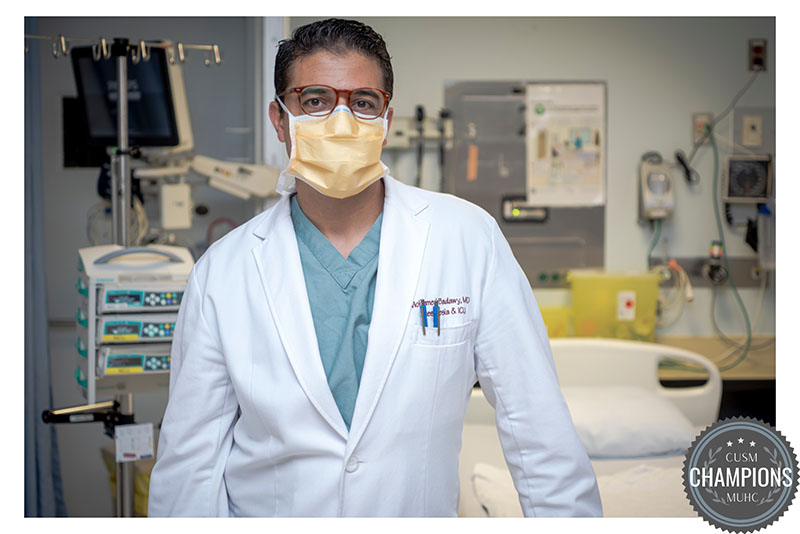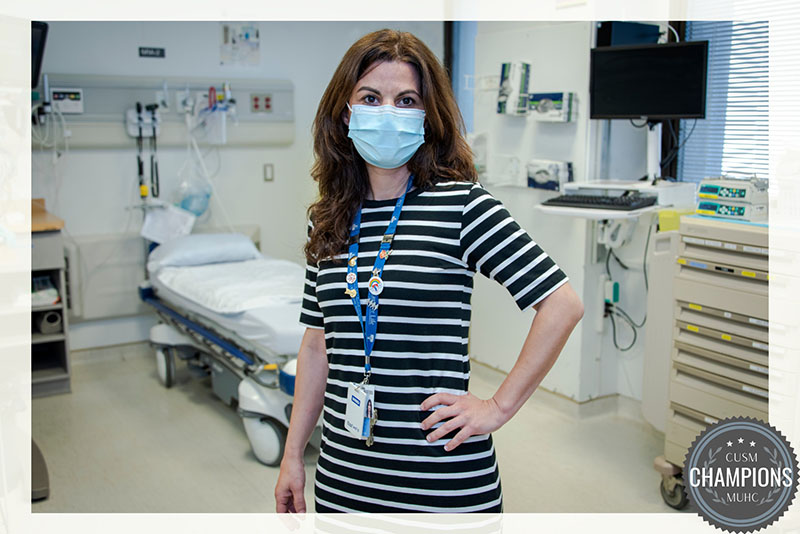Stroke care during COVID-19: Training and new protocols to boost safety and confidence
When the COVID-19 pandemic began, The Neuro’s stroke service had to immediately re-evaluate the way they provided care. Among others, Dr. Mohamed Badawy and Georgia Niarchos took a leading role in overcoming this sometimes-overwhelming challenge.
Dr. Badawy found himself in an ideal position to direct the stroke unit’s pandemic response. As chief of anesthesia at The Neuro and a member of ICU team, the RED Unit service (the receiving area for stroke patients) and hospital’s executive committee, he regularly interacts with leaders and representatives of departments and services. This knowledge allowed him to build a multi-disciplinary team to tackle the challenge of rethinking and rebuilding stroke care during the COVID-19 pandemic.

Early on in the pandemic, The Neuro was designated a non-COVID hospital, meaning it would not treat COVID patients, to be able to fulfill its mandate of providing highly specialized neurological care. But in the Red Unit, which provides emergency care, the potential to receive patients infected with COVID-19 created unique challenges for Dr. Badawy and his colleagues.
“This was a major change in the way we practice,” he says. “Entirely new pathways and protocols had to be created from scratch to treat stroke patients who were potentially infected with COVID. We needed to figure out how to optimally treat patients with a stroke while keeping everyone else in the hospital safe from COVID.”
Coordinating a response
Dr. Badawy helped coordinate the pandemic response, working with multiple departments and the hospital administration. They created negative pressure rooms, where patients are intubated without risk of spreading COVID-19. As well, they created new protocols specifying that patients be intubated before going into the operating room, to prevent contamination in the event the patient is COVID-positive.
Georgia Niarchos, associate director of the Neuroscience Mission at the McGill University Health Centre (MUHC), had to make sure that the new pathways and protocols conformed to the frequently changing recommendations made by the Infection Control team and that they were communicated to the teams across The Neuro. “It was my responsibility to make sure that the whole trajectory of the patient was covered. From the minute they come into the hospital by ambulance to the testing area for a CT scan or thrombectomy, back to the Intensive Care Unit for recovery and then back to a regular in-patient unit. The teams from each area had to be aware of the new processes,” says Georgia.
The multidisciplinary team then developed a list of every hospital staff member who would be near patients, to train them all. This was a major undertaking as it included nurses, doctors, respiratory therapists, radiology technologists and other professionals across different teams. Every department of the hospital was involved.
“Anyone potentially exposed needed to be trained,” Dr. Badawy says. “It was a huge undertaking to round these people up to make sure they received the training or saw the video.”
The new measures quickly paid off. COVID-positive stroke patients were quickly identified and transferred out shortly after being treated for stroke without contaminating healthcare workers or other patients.

The ever-changing nature of the virus and the fact that so little is known about it caused fear and anxiety among the staff. Besides the training, which helped boost everyone’s confidence, the multidisciplinary team decided to find different ways to help staff manage the new situation. “We adopted an open-door policy to offer support to individuals by having conversations with them to discuss coping strategies,” says Georgia.
Dr. Badawy says this has been one of the greatest challenges of his career.
“I’m in a unique position,” he says. “I wear many hats and I work in many different departments and know how they function. This bird’s eye view of the hospital allowed me to identify what needed to be done to create a safe working environment and to implement the necessary changes by engaging all teams involved.”
Like champions, the Neuro team adapted quickly to ensure the safety of patients and staff and as a result of the challenges, they have become a better team for it. “We have become much more supportive of each other; we are better listeners, more open to different points of view and we have created a more collaborative relationship with our partners,” adds Georgia.
Source: The Neuro

